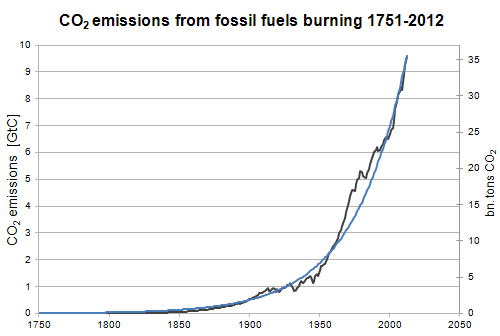If scientists agree that the greenhouse effect is approximately logarithmic — which means that as we add more CO2 to the atmosphere, the effect of extra CO2 decreases, why does the IPCC projects that if we don't take steps to reduce our emissions, global warming won't just get worse, it will speed up?
The answer can be found in a 28 March 28, 2018 post by DPiepgrass at
https://skepticalscience.com/why-global-warming-can-accelerate.html

Growth of carbon dioxide emissions from burning fossil fuels during the period 1751-2012 (black line); source: CDIAC. Blue line represents exponential function growing at a rate of 2.8% per year (i.e. doubling every 25 years).
CO2 emissions are doubling every 25 years. After 50 its 4x, after 75 its 8x, and after 100 its 16x larger.
Carbon Sink Saturation
The main natural carbon sinks are plants, the ocean and soil. Plants grab carbon dioxide from the atmosphere to use in photosynthesis; some of this carbon is transferred to soil as plants die and decompose. The oceans are a major carbon storage system for carbon dioxide. Marine animals also take up the gas for photosynthesis, while some carbon dioxide simply dissolves in the seawater.
Combined, the Earth’s land and ocean sinks absorb about half of all carbon dioxide emissions from human activities. (Paul Fraser of the Commonwealth Scientific and Industrial Research Organization)
https://skepticalscience.com/why-global-warming-can-accelerate.html
Although CO2 has less effect at higher CO2 concentrations, this "logarithmic effect" is overpowered by these 4 factors:
- Exponential growth of energy use
- Past CO2 emissions that nature has not yet absorbed
- Carbon sink saturation
- Committed warming
Exponential growth of CO2 emissions
Historical carbon dioxide emissions can be approximated using exponential function, i.e. one that grows by a constant factor every year. That means continually increasing growth rate. In Figure 4 an exponential function growing at a rate of 2.8% yearly was superimposed on the graph of historical CO2 emissions.
Growth of carbon dioxide emissions from burning fossil fuels during the period 1751-2012 (black line); source: CDIAC. Blue line represents exponential function growing at a rate of 2.8% per year (i.e. doubling every 25 years).
CO2 emissions are doubling every 25 years. After 50 its 4x, after 75 its 8x, and after 100 its 16x larger.
Carbon Sink Saturation
The main natural carbon sinks are plants, the ocean and soil. Plants grab carbon dioxide from the atmosphere to use in photosynthesis; some of this carbon is transferred to soil as plants die and decompose. The oceans are a major carbon storage system for carbon dioxide. Marine animals also take up the gas for photosynthesis, while some carbon dioxide simply dissolves in the seawater.
Combined, the Earth’s land and ocean sinks absorb about half of all carbon dioxide emissions from human activities. (Paul Fraser of the Commonwealth Scientific and Industrial Research Organization)
The sink strength shows high interannual variability and there is evidence that the sink cannot be sustained indefinitely. It is conceivable that by the end of this century or earlier the terrestrial sink may significantly decrease or disappear.
Committed warming
Committed warming refers to future warming effects that would still happen even if CO2 levels stop increasing. A large source of delayed warming worldwide is the oceans, which have not kept up with the warming of the land:
Earth's climate system has feedback loops that magnify the warming effect of CO2. For example, as the arctic ice melts, it exposes ocean. The ocean is much darker than the ice, so more sunlight is absorbed instead of being reflected back to space. This enhances the arctic warming effect. This effect is time-delayed, since it takes many years for the arctic ocean to warm up (which in turn causes the ice to melt more quickly in the future, which in
turn helps the ocean to heat up even more.

No comments:
Post a Comment